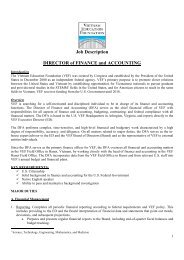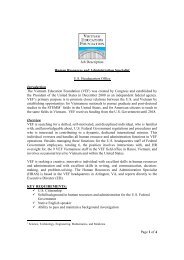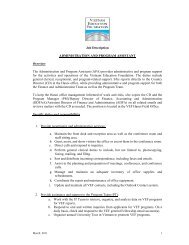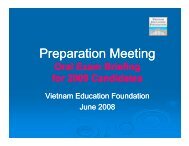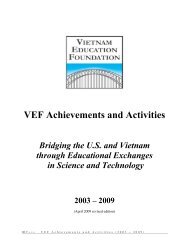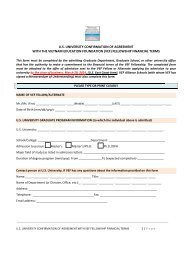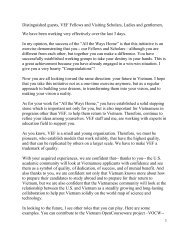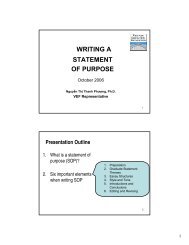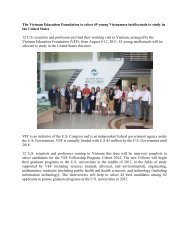The Vietnam Education Foundation 2011 Annual Report
The Vietnam Education Foundation 2011 Annual Report
The Vietnam Education Foundation 2011 Annual Report
You also want an ePaper? Increase the reach of your titles
YUMPU automatically turns print PDFs into web optimized ePapers that Google loves.
Page 72 <strong>Annual</strong> <strong>Report</strong> <strong>2011</strong><br />
<strong>Vietnam</strong> <strong>Education</strong> <strong>Foundation</strong><br />
Notes to Financial Statements<br />
September 30, <strong>2011</strong> and 2010<br />
NOTE 1 – SIGNIFICANT ACCOUNTING POLICIES (CONTINUED)<br />
Personnel Compensation and Benefits (continued)<br />
Employees are entitled to participate in the Federal Employees Group Life Insurance (FEGLI) Program. Participating<br />
employees can obtain “basic life” term life insurance, with the employee paying two-thirds of the cost and VEF<br />
paying one-third. Additional coverage is optional, to be paid fully by the employee. <strong>The</strong> basic life coverage may be<br />
continued into retirement if certain requirements are met. OPM administers the FEGLI program and is responsible for<br />
the reporting of related liabilities. Each fiscal year, OPM calculates the U.S. Government’s service cost for the postretirement<br />
portion of basic life coverage. Because VEF’s contributions to the basic life coverage are fully allocated by<br />
OPM to the pre-retirement portion of coverage, VEF has recognized the entire service cost of the post-retirement<br />
portion of basic life coverage as an Imputed Cost and Imputed Financing Source.<br />
Fund Balance with Treasury<br />
<strong>The</strong> U.S. Treasury performs cash management activities for all Federal agencies. Fund Balance With Treasury is the<br />
aggregate amount of the agency’s accounts with Treasury for which the agency is authorized to liquidate obligations,<br />
pay funded liabilities, and make expenditures. <strong>The</strong> fund balance is increased through the receipt of non-expenditure<br />
Treasury Warrants for appropriations, positive non-expenditure transfers, and other expenditure inflows of funds. <strong>The</strong><br />
Fund Balance With Treasury is reduced through non-expenditure Treasury Warrants for rescissions, negative nonexpenditure<br />
transfers, disbursements, and other expenditure cash outflows of funds.<br />
Property and Equipment<br />
Property, plant, and equipment (PP&E) have been defined in the Federal Government as tangible items owned by the<br />
Federal Government and having an expected useful life of greater than two years. <strong>The</strong> following policies will be<br />
effective for PP&E:<br />
PP&E will be reported at acquisition cost.<br />
<strong>The</strong> capitalization threshold will be established at $5,000 for assets with a useful life of 2 or more years.<br />
For bulk purchases, items will be capitalized when the individual useful lives are at least two years and have an<br />
aggregate value of $100,000 or more.<br />
Acquisitions of P&E that do not meet the capitalization criteria will be recorded as operating expenses. General P&E<br />
consists of items that are used by to support its mission.<br />
Depreciation on these assets is calculated using the straight-line method. Depreciation begins the day the asset is<br />
placed in service.<br />
15



